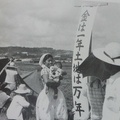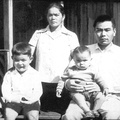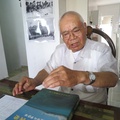Tomoji Yara (78), an Isahama immigrant living in the Casa Verde area of the city of Sao Paulo, and his family worked on a Manila hemp plantation in Davao, Philippines, before the war. When the war began, they were driven away as enemy nationals and lived as refugees along with other Japanese people. They ran around without enough food to eat, and everyone got sick, including with bad legs. During this time, two of his brothers died of malnutrition.
After the war ended, they were taken to a camp where they lived in tents set up outdoors. There was also a food shortage, and her older brother, who had been happy that he could finally return to Japan, died of malnutrition.
After spending about a year at the camp, he returned to Japan, was hospitalized in a hospital on the mainland, and then returned to Okinawa. Since he was not allowed to enter Isahama, he spent a year at his relatives' house in Nodake, Ginowan City. When he returned to Isahama, his house was half-destroyed.
After the Isahama land struggle, the land was confiscated, but the house was not demolished, so they continued to live in it. However, because it was near the coast, seawater flooded the house every time there was a typhoon or high tide.
Regarding her father's decision to go to Brazil, Yara said, "I think he thought he would rather go to a foreign country with more land than struggle in Okinawa. He had experience in Davao, after all." She continued, "I also thought it would be a good idea to get out of Okinawa."
However, life in Brazil was not easy. The Isahama immigrants were divided into groups of five families and assigned to work on two coffee plantations in Toppan, inland of the state of São Paulo. The Yara family was part of the Shimabukuro group, along with the Tasato and Sawano families. Their fingers were covered in beans from the unfamiliar work, and the yield depended on the weather. They stayed in Toppan for about two years, then moved to other farms, but during that time they had no savings at all.
At the same time, Sawatari had a newborn baby. He said, "I was the youngest head of the household out of the 10 families, and I also had the least money. My wife and I were both busy with work, so we couldn't take care of our child properly. When I came home from farm work, I saw my child crawling out of the bedroom and sleeping in the kitchen. I burst into tears. I wondered if I had come to Brazil to abandon my child."
At the time, the land struggle was widely reported in Okinawa, but few people in Brazil knew about it, and they received no sympathy. "We were not special in Brazil. Everyone was suffering, and we had no choice but to do it without complaining," recalls Tomonori Tasato.
It was only after they gave up farming and became saints that their lives became easier. In 1963, the Tasato family started selling grains and other products in the city of São Paulo. They set up shop in a busy area, and sales soared.
The prosperity of the Tazato family was remarkable after that. Around 1966, they built a large two-story house, and used the first floor as a warehouse to store inventory. At the time, there was no other house of that size in the Casa Verde area.
Ten years later, he built and managed a supermarket in Osasco, São Paulo. He then built a second store in Barueri, which is now run by his younger brother and children. In the 1980s, Tomonori bought land in Goiânia, Goiás, which is now a ranch with about 500 cows and a 1,400-hectare soybean farm.
*This article is reprinted from the Nikkei Shimbun (March 17, 2018).
© 2018 Rikuto Yamagata / Nikkey Shimbun







